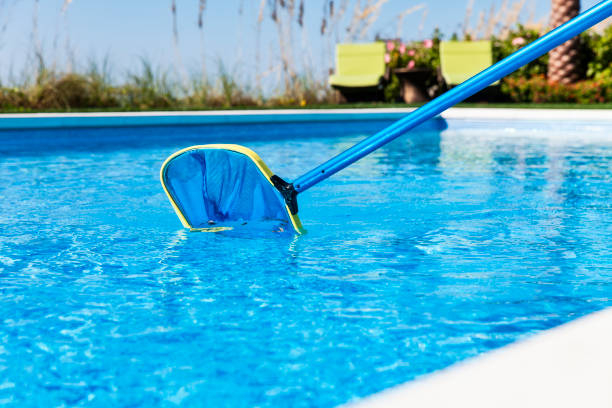
The maintenance of your swimming pool is essential to preserve the quality of the water in the pool and meets several objectives.
Filtration circuit, treatment products to keep the water in perfect balance, disinfection, cleaning of the waterline, the walls, the bottom, the Skimmer basket, etc. the planning of the operations are varied and more or less frequent. Regular checks by your professional pool cleaner will allow you to enjoy the pure, clear water of your pool while preserving your health and the durability of your equipment. This article presents the essential points for properly maintaining your above-ground or in-ground swimming pool and guaranteeing pleasant bathing water.
Swimming pool filtration
Filtration is a mechanical treatment of swimming pool water that purifies it by retaining all the impurities in suspension which pollute the pool with insects, leaves, twigs, etc. The filtration system alone provides 80% of the maintenance. We will eliminate everything that we cannot remove by filtration by chemical treatment: algae, bacteria, viruses.
Swimming pool water treatment
Swimming pool water is a very sensitive living environment, conducive to the proliferation of microorganisms. It therefore requires adequate operations. The following are the different targets:
- Maintain disinfectant properties, keep it looking limpid; facilitate routine maintenance operations. Keep equipment in good working order and extend its lifespan (filter, water line, etc.). Preserve the pH balance, maintain the quality of bathing water.
The treatment that we need to execute in several stages using equipment, systems and pool maintenance products.
Water preparation
The preparation of swimming pool water aims to eliminate as many elements as possible in it, in order to optimize the effectiveness of disinfection. It is carried out using a landing net, a robot or Flocculant – 5 L liquid flocculant. Present on the market in the form of liquid or powder tablets, swimming pool flocculant is intended to collect all the fine particles that escape sand filters and are invisible to the naked eye, so that they clump together and form larger particles. They can then be filtered.
Water analysis and standardization
This step consists of checking the measurements of 3 parameters:
- the hydrogen potential (pH),
- the Complete Alkalimetric Title – TAC,
- the Hydrotimetric Title – TH.
The potential of hydrogen
pH refers to the level of acidity or basicity of water. It undergoes variations for various reasons: weather, treatment products, outside temperature, frequency of bathing, filtration, etc. The ideal pH of swimming pool water is between 7.2 and 7.8.
- Too high a pH considerably reduces or cancels the disinfectant function of oxidizing products. It stings the eyes, causes the appearance of micro-organisms and fine lines on the liner – Ph Less, 34 Kg.
- A pH that is too low causes red eyes, triggers the corrosion of metal equipment in the pool, oxidizes the metal particles dissolved in the water and degrades the liner.
The Hydrotimetric Title
The TH expresses the mineralization rate of the water which corresponds to the concentration of calcium and magnesium ions. It is measured in degrees (°F) and is used to determine the hardness of the water.
- Soft water (aggressive and corrosive for equipment) has a value between 10 and 20° F.
- Medium hard water is between 20 and 30°F (hard water).
The Complete Alkalimetric Title
The TAC of the water makes it possible to know its concentration in calcium bicarbonate and determines its alkalinity.
- Balance of alkalinity is the buffering power of water, its ability to stabilize its ph.
- A very high TAC prevents the pH of the water from varying.
We can measure and use test strips, readers and electronic testers.
Water disinfection
We can disinfect the water with disinfectant and oxidizing products, algaecides (anti-algae) or by salt electrolysis.
Oxidizing disinfectants
They eliminate impurities and the many organisms that rapidly proliferate in the pool (viruses, fungi, bacteria, algae). The most common techniques being chlorine, active oxygen and bromine.
- Chlorine is found in the form of liquid, granules, pebbles or chlorine tablets – slow chlorine pebbles 10 kg.
- Bromine is generally available in the form of white tablets – Brome tablet 5 kg.
- Active oxygen (treatment without chlorine) comes in the form of pebbles, granules or liquids.
Algaecides
We can use a specific anti-algae product like algaecide, to prevent and to fight against the development of algae.
Salt electrolysis
Salt electrolysis is an automatic treatment process that relies on a chemical reaction through the conversion of electrical energy into chemical energy. Just add a small amount of salt to the pool water. Passing through the device, the salt can replace chlorine with its disinfectant properties.
Clean your pool daily
Swimming pool maintenance includes cleaning tasks that must be carried out regularly by a professional pool cleaning company. We can clean it manually or with devices (vacuum cleaner, pool robot) to keep the water clean and the pool in good condition.
- Cleaning the water line to remove lime deposits (pool brush, silver stone, magic sponge, anti-mark product, etc.) – alkaline water line cleaning gel.
- Passage of the landing net to remove leaves, insects, etc.
- Cleaning the bottom and walls of the pool to remove dirt and greasy deposits
- Cleaning of filtration equipment: emptying the skimmer basket, cleaning the pump and the filter.
Read More: Benefits and Drawbacks of Using Job Placement Agencies



